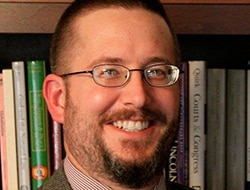
If, for the Christian, the only legitimate purpose of any kind of writing is to express truth, where does fiction fit in? In our everyday language, we oppose fiction to fact, as if the latter is true and the former is false. But “fact = truth” and “fiction = falsehood” are both half-truths, at best, and as the Catholic historian John Lukacs used to say, half-truths are more dangerous than lies.
The mere marshaling of facts — bits of knowledge that are either self-evidently true or have been proved to be such — is no guarantee that the narratives we build around those facts are true. If Dec. 23, 2020, should turn out to be the coldest day on record here in Huntington, Indiana, that would no more prove that global warming is false than July 16, 2020, being the warmest day on record would prove that it is true. That the sun rises in the east is a fact, but it means something very different to the person who believes that the earth is the center of the universe than it does to the person who accepts that the earth travels around the sun.
Those who write fiction don’t enter into the process with the intention of “making things up,” in the sense of lying. A fictional narrative may never have occurred, but the point of fiction is to illuminate the truth, rather than to obfuscate it. For several decades, John Lukacs pursued the idea that the writing of history and of literature might one day converge, not just in the sense that a well-written history ought to read like good literature, but in the sense that the best literature may better express the essence of historical truth than a history that’s merely the marshaling of facts (what did happen) with no recognition of potentiality (what could have happened).
As the Dutch historian Johan Huizinga wrote: “The historian … must always maintain toward his subject an indeterminist point of view. He must constantly put himself at a point in the past at which the known factors still seem to permit different outcomes. If he speaks of Salamis, then it must be as if the Persians might still win.” John Lukacs quotes those lines in the Introduction to “A Thread of Years” (1998), perhaps his most ambitious book — a work of fiction and of history, in which he attempts to illustrate the reality of actual places at particular points in time through vignettes of people who did not actually exist.
In creating fictional characters to illuminate historical potentialities, Lukacs solved a problem that Wendell Berry faced in “The Hidden Wound”: “To fictionalize [Nick and Aunt Georgie], as I did Aunt Georgie to some extent in ‘A Place on Earth,’ would be to give them an imaginative stability at the cost of oversimplifying them.” Nick and Aunt Georgie were shaped by their actions, but like every one of us they were also more than the sum of their actions: What we could have been, the roads that we did not take — whether through choice, inertia, or the actions of others — are part of what we are, as well.
Fiction can explore those potentialities in a way that even a history in which the Persians might win cannot. In doing so, the writer of fiction can illuminate deeper truths of the past — to inform our present and provide us with imaginative resources to draw on as we forge our future.
Scott P. Richert is publisher for OSV.





